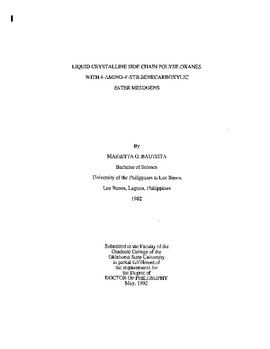| dc.contributor.advisor | Ford, Warren T. | |
| dc.contributor.author | Bautista, Marietta O. | |
| dc.date.accessioned | 2015-09-17T17:44:35Z | |
| dc.date.available | 2015-09-17T17:44:35Z | |
| dc.date.issued | 1992-05 | |
| dc.identifier.uri | https://hdl.handle.net/11244/18269 | |
| dc.description.abstract | Solid, liquid, and gas are the three states of matter. A solid consists of molecules or ions that are fixed in a specific position. Strong attractive forces hold the molecules in place. Hence, three-dimensional order is maintained in a crystalline solid. On the other hand, the forces holding the molecules together in the liquid state are much weaker. Thus, the molecules are free to move randomly and the order is much less than in a solid. Solids are hard and difficult to deform while liquids flow and are easily deformed. In a gas, the molecules move randomly as in liquids, but the attractive forces are not strong enough to hold the molecules close together. A gas can be deformed even more easily than a liquid. A phase is a sample of matter with uniform properties. A state of matter can have one or more phases. Increasing the temperature of a substance increases the molecular motions and the phase is changed at a precise temperature. A completely disordered phase is called isotropic. Thus, most liquids and gases are isotropic. Liquid crystal (LC) is an intermediate phase between the crystalline solid and the isotropic liquid. When a solid melts to an LC phase, the material flows as a liquid, but the molecules retain order in one or two dimensions. Although, an LC phase is anisotropic, it is more similar to a liquid than to a crystalline solid because it only possesses a small amount of order. | |
| dc.description.abstract | The purpose of this work was to prepare and understand the properties liquid crystal polymers (LCPs) which have the shape of a comb. A polymer is a substance consisting of giant molecules formed as chains or networks from smaller molecules (monomers) of the same kind. In the comb-shaped LCPs, relatively long rod-shaped side branches bound to the main chain comprise the teeth and the backbone of a comb, respectively. The comb polymers were made by a reaction that binds the teeth to a preformed polymer backbone of poly(methylhydrosiloxane), a polymer similar to that of silicone oil and silicone rubber which is among the most flexible polymers known. The flexibility of the backbone allows the preparation of polymers having low glass transition temperature, T g ( the temperature at which a rubbery liquid changes to a glass or vice versa). A spacer chain was placed between the main chain and the side chain to allow main chain motion without disturbing the orientation of the side chains which gives the LC properties of the polymers. | |
| dc.description.abstract | The LC properties of the comb-shaped polymers were examined using a differential scanning calorimeter (DSC), a polarizing microscope, and a high temperature X-ray diffractometer. DSC detects the temperatures at which change of phase occurs and measures the energy change of a phase transition. A LC phase is best observed by a microscope. Due to the orientational order of LCs, polarized light is transmitted. The arrangement of the molecules in different phases is obtained from the X-ray diffractometer. One or two LC phases were observed for each polymer depending on the size of the side chains. | |
| dc.description.abstract | LCs are commonly known for their application as displays (LCD) for watches, calculators and other digital displays. In this work, the polymers were investigated for possible nonlinear optical applications. The polymers prepared in the laboratory showed promising nonlinear optical response which can be compared to materials currently used as laboratory standards. | |
| dc.format | application/pdf | |
| dc.language | en_US | |
| dc.rights | Copyright is held by the author who has granted the Oklahoma State University Library the non-exclusive right to share this material in its institutional repository. Contact Digital Library Services at lib-dls@okstate.edu or 405-744-9161 for the permission policy on the use, reproduction or distribution of this material. | |
| dc.title | Liquid crystalline side chain polysiloxanes with 4-amino-4'-stilbenecarboxylic ester mesogens | |
| dc.contributor.committeeMember | Devlin, J. Paul | |
| dc.contributor.committeeMember | Holt, Elizabeth M. | |
| dc.contributor.committeeMember | Powell, Richard C. | |
| osu.filename | Thesis-1992D-B352l.pdf | |
| osu.accesstype | Open Access | |
| dc.type.genre | Dissertation | |
| dc.type.material | Text | |
| thesis.degree.discipline | Chemistry | |
| thesis.degree.grantor | Oklahoma State University | |
